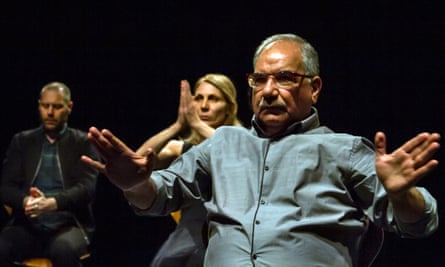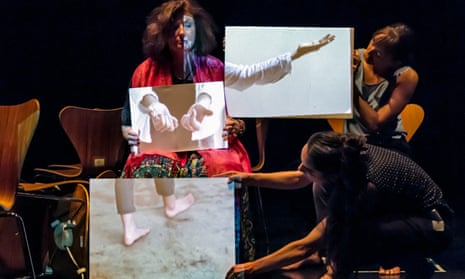It was around four in the morning when Pauline Boye woke up and realised she couldn’t move. “I was unable to get up,” she remembers. “I called to my partner, ‘Can you help me? I can’t get up!’”
Boye, who was 47, had suffered a stroke. She spent four months in hospital, and was left with physical impairment down her right side and difficulty with her speech. The former nurse suddenly went from caring for others to being the one in need of care. Once she was home, she didn’t want to leave the house. “I was ashamed,” she says. “I was fixed on asking, ‘Why me?’ I didn’t want most of my friends, or even family, to know.”
Boye was shy even to speak, worried that people wouldn’t understand her. But eight years later, on stage in front of me, she is acting out a scene based on her time in hospital, her voice carrying across the stage. Clearly she is not ashamed any more.
The transformation is thanks to the organisation Rosetta Life and its director, Lucinda Jarrett, who works with artists and health professionals to devise arts projects that have a meaningful impact on the lives of people with brain injuries. For Boye, this now means touring the country as a performer in Stroke Odysseys, a production by choreographer and director Ben Duke and the composer Orlando Gough, featuring a cast of musicians, dancers and five stroke survivors.
In a south London rehearsal studio, Boye and the rest of the cast sit on stage and let their hands dance, tracing triangles in the air. One person’s hand quivers, as if they’re plucking the strings of an invisible harp; another’s fingers curl at unexpected angles. The physicality of each person is different and shows vulnerability but also determined strength. Through a series of scenes and songs, the performers’ experiences – of struggling to express themselves, mixing up words – come to life, with projections cleverly revealing inner thoughts and subtext.

Duke, the director of dance theatre company Lost Dog, uses text and movement – in this case music and song – to tell stories. He’s had rave reviews for his funny and very human reworkings of Paradise Lost and Romeo and Juliet. In Stroke Odysseys, he is interested in putting real people on stage, in all their complexity.
“This group of people, their backstories are extraordinary,” he says. One of the cast, Jawad Mohammed, was a lecturer in Iraq and ran an NGO focused on fighting corruption. “These are mind-blowing backstories … These people who’ve had amazing jobs, amazing lives, suddenly don’t have a reason to get out of bed,” says Duke. “We complain about work but without that, how do you build your identity? How do you keep going?”
The discipline of rehearsals, the camaraderie and the drive towards performance can offer very real motivations and therapeutic benefits. “The key outcomes are increased mobility, increased cognition, increased verbal articulacy,” says Jarrett. One in three people experience depression after a stroke, but evaluations of Rosetta Life’s work shows that it has “enabled people to change the perception of their disability and look forward to a new life”, says Jarrett. Reducing depression means people stay more active and are less isolated, and hopefully therefore less prone to accidents, second strokes and hospital readmissions.

In that light, it is surprising when Duke says: “I’m interested in the idea of dance as a useless activity.” But he goes on to explain the benefits of physical activity that have no practical function. When you lose the use of one hand, for example, you tend to use your other hand instead, and the impaired hand becomes weaker as a result. Whereas with dance, the performers are asked to make gestures simply because it’s the choreography, and they’re forced to do things they might not otherwise.
“It’s helped me loads,” says Boye, lifting and uncurling her fingers. “Before, I couldn’t make use of this arm. My hand would not open like this!” After her stroke, Boye no longer felt like herself. “Before, I loved travelling, going to parties, dancing,” she says. But she has found renewed confidence.
“For Pauline, dancing was a big part of her life,” Duke says, remembering the day she brought in some videos of her dancing at a wedding. “But the first time she talked about it, she stood up and she [danced], and even now with her limited movement, it’s all there. Physically it is a fraction of how she used to be, and yet, it’s there. The body lights up.”

Comments (…)
Sign in or create your Guardian account to join the discussion